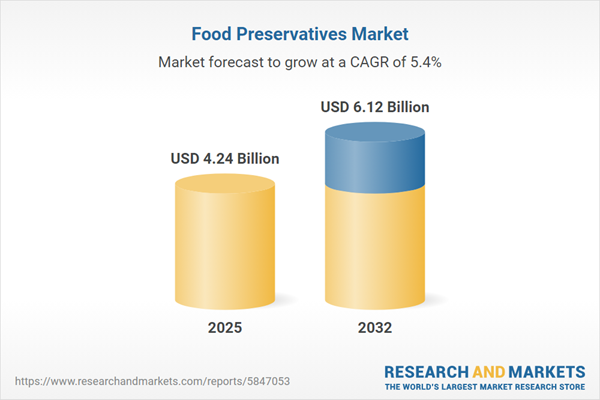Speak directly to the analyst to clarify any post sales queries you may have.
The food preservatives market is experiencing rapid evolution, shaped by consumer demand, regulatory change, and ongoing technology advances. Senior decision-makers are seeking pathways to maintain compliance, competitive differentiation, and operational efficiency in a landscape defined by accelerating innovation and diverse supply chain needs.
Market Snapshot: Food Preservatives Sector Overview
The global food preservatives market recorded strong growth, increasing from USD 4.03 billion in 2024 to USD 4.24 billion in 2025. With a projected CAGR of 5.35%, the sector is on course to reach a value of USD 6.12 billion by 2032. Growth is driven by persistent demand for clean-label and sustainable solutions, ongoing regulatory shifts, and advances in preservation technologies. Organizations are revisiting their long-term strategies as they face intensified innovation cycles and expanded international competition. The market environment demands agile responses and a forward-looking approach to capture emerging growth opportunities across diverse industry verticals.
Scope & Segmentation of the Food Preservatives Market
This report delivers an in-depth assessment of the core segments shaping the food preservatives market, focusing on operational realities and forward-looking opportunities for both established firms and new entrants. Granular coverage ensures relevant insights for strategic planning and execution.
- Application: Preservatives are used across bakery and confectionery, beverages, dairy, and meat and poultry products, demonstrating a broad footprint in essential food segments.
- Function: These products serve as antimicrobial agents, antioxidants, chelating agents, and enzymatic preservatives, each addressing specific requirements for shelf life, safety, and formulation stability.
- Source: Food preservatives are derived from plant extracts, microbial fermentation, and synthesized compounds like benzoates, propionates, and sorbates, aligning with compliance targets and evolving consumer standards.
- Form: Markets accommodate products offered as granules, liquids, and powders, alongside advanced delivery mechanisms such as coated, concentrated, freeze-dried, and spray-dried formats, which optimize process consistency and product integrity.
- End Use: The report addresses usage in commercial processing, food service supply, and household applications, confirming a robust presence across the B2B and consumer domains.
- Distribution Channel: Market participants leverage direct sales, distributor networks, digital platforms, and retail outlets for flexible outreach that supports commercial and end-consumer access.
- Region: Strategic approaches vary by Americas, Europe/Middle East/Africa, and Asia-Pacific, reflecting localization to region-specific regulatory conditions and infrastructural dynamics.
- Key Companies Covered: Leading enterprises profiled include International Flavors & Fragrances Inc., Kerry Group plc, Koninklijke DSM N.V., Eastman Chemical Company, BASF SE, Lonza Group Ltd., Ashland Global Holdings Inc., Brenntag AG, Clariant AG, and Nouryon Holding B.V.
Key Takeaways & Strategic Insights
- Growing consumer preference for natural food solutions is steering R&D efforts toward plant-based and bioengineered preservative development, expanding available market alternatives and value chain diversity.
- Organizations are facing heightened regulatory scrutiny, prompting enhanced data management and compliance validation practices to navigate stricter market standards.
- Supply chain resilience is emerging as a top priority, with companies increasingly optimizing logistics and sourcing ingredients locally to minimize exposure to global policy disruptions and adapt to region-specific regulations.
- Technological progress in analytics and artificial intelligence is advancing shelf-life prediction and improving the reproducibility of product formulation, supporting consistent quality and reduced waste.
- Strategic R&D partnerships are enabling access to next-generation preservation technologies, supporting both innovation pipelines and competitive differentiation, particularly for smaller enterprises or those entering new market segments.
- Portfolio diversification provides companies with flexibility to respond to changing consumption habits, securing their market role in increasingly segmented and dynamic ecosystems.
Tariff Impact on U.S. Food Preservatives Market
Recent tariff policy changes in the U.S. are causing many companies to reevaluate supplier alliances and prioritize sourcing ingredients closer to production sites. These adjustments help manage operational costs and maintain a stable competitive position in the face of shifting trade regulations. Sourcing strategies that emphasize local or regional suppliers can enhance supply chain agility and help organizations better respond to ongoing market changes.
Methodology & Data Sources
The research underlying this food preservatives market report is based on analysis from peer-reviewed publications, official regulatory guidance, industry reports, and direct interviews with key market stakeholders. All projections rely on cross-validation and triangulated methodologies, supporting actionable and reliable insights for executive decision-making.
Why This Food Preservatives Market Report Matters
- Guides executive teams in responding to consumer trends, regulatory dynamics, and technological shifts by equipping them with actionable segmentation and unbiased methodology.
- Informs product innovation and supports optimal supply chain planning with market-specific intelligence for both mature and emerging regions.
- Facilitates organizational adaptability and localization, helping companies remain alert to risks and opportunities as industry landscapes evolve.
Conclusion
Senior leaders will gain a comprehensive perspective to anticipate regulatory demands and competitor responses. Up-to-date, data-driven insights in this report offer essential guidance for risk management and future growth in the food preservatives sector.
Additional Product Information:
- Purchase of this report includes 1 year online access with quarterly updates.
- This report can be updated on request. Please contact our Customer Experience team using the Ask a Question widget on our website.
Table of Contents
3. Executive Summary
4. Market Overview
7. Cumulative Impact of Artificial Intelligence 2025
List of Figures
Samples

LOADING...
Companies Mentioned
The key companies profiled in this Food Preservatives market report include:- International Flavors & Fragrances Inc.
- Kerry Group plc
- Koninklijke DSM N.V.
- Eastman Chemical Company
- BASF SE
- Lonza Group Ltd.
- Ashland Global Holdings Inc.
- Brenntag AG
- Clariant AG
- Nouryon Holding B.V.
Table Information
| Report Attribute | Details |
|---|---|
| No. of Pages | 181 |
| Published | October 2025 |
| Forecast Period | 2025 - 2032 |
| Estimated Market Value ( USD | $ 4.24 Billion |
| Forecasted Market Value ( USD | $ 6.12 Billion |
| Compound Annual Growth Rate | 5.3% |
| Regions Covered | Global |
| No. of Companies Mentioned | 11 |









